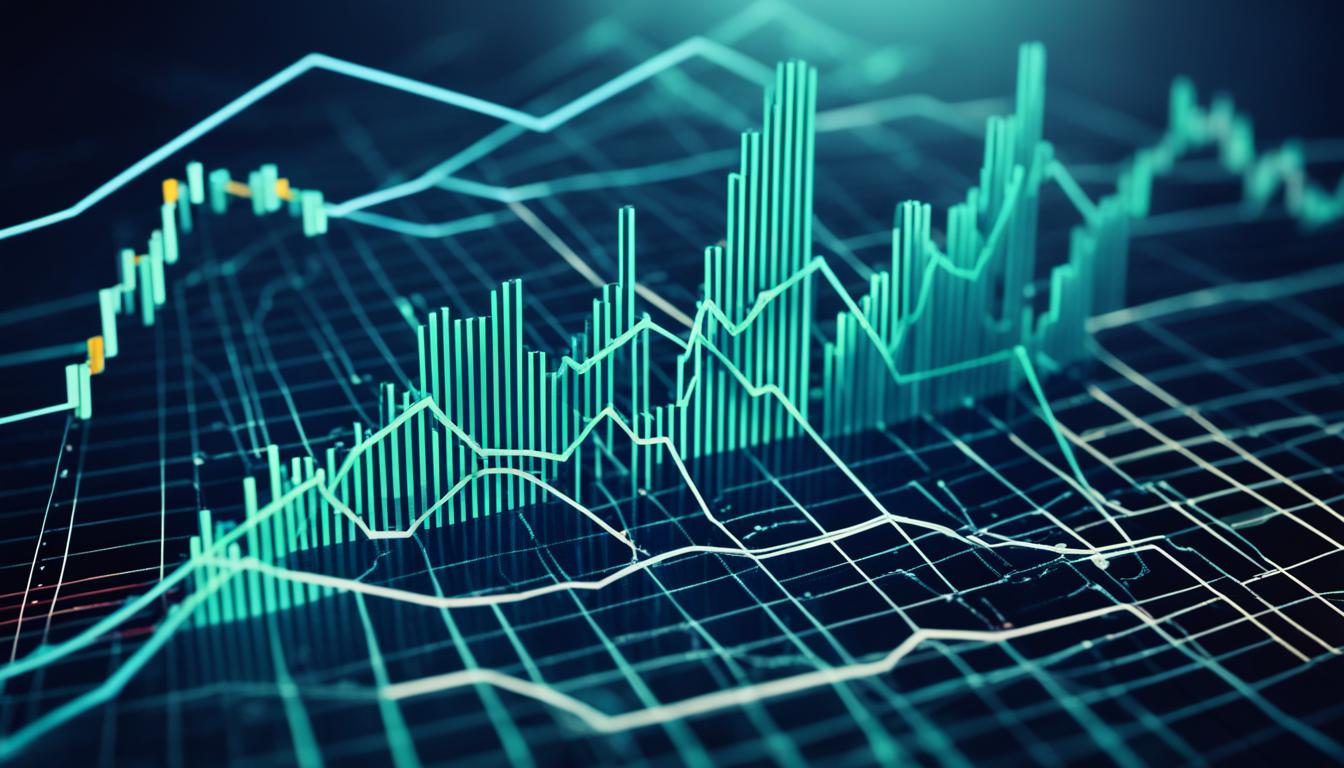
Did you know that 96% of all cryptocurrency trading volume comes from technical analysis? This fact shows how important charts and indicators are in crypto investing. As a professional journalist, I’m excited to share tips and strategies for trading crypto with confidence.
Technical analysis is key to trading crypto well. By looking at past price trends in charts, traders can learn about market feelings, trends, and where prices might go next. This helps them make smart choices and grab market chances.
Key Takeaways
- Technical analysis is crucial for getting the crypto market and making smart trades.
- Crypto charts and indicators offer deep insights into market trends, feelings, and where prices might head.
- Learning technical analysis, like support and resistance, can give traders an edge in crypto.
- Indicators like moving averages, MACD, and RSI help spot trends and trading chances.
- Using advanced technical analysis and the right tools can boost your trading results.
What is Technical Analysis?
Technical analysis is a way to predict future asset prices by looking at past data, like price and volume. It uses charts, indicators, and patterns to spot trends and trading chances. This method doesn’t look at a company’s financial details like fundamental analysis does. Instead, it focuses on market data to make investment choices.
The Principles of Technical Analysis
This approach believes market movements follow patterns and trends that can help predict future prices. Key ideas include that prices reflect all known info, markets trend, and history often repeats itself.
A Brief History of Technical Analysis
The history of technical analysis goes back to the late 19th century. Charles Dow, who started The Wall Street Journal, developed the Dow Theory. He thought the stock market had distinct trends, which helped him create the Dow Jones Industrial Average.
Over time, technical analysis has grown and changed. New charting methods, indicators, and trading strategies have been developed.
“The market is a discounting mechanism. It reflects all known information and discounts the future.”
This idea, known as the Efficient Market Hypothesis, says asset prices already include all available info. The market quickly adjusts to new info, making it very efficient.
Cryptocurrency Charts and Their Types
Cryptocurrency trading relies heavily on charts for technical analysis. These tools help traders understand market trends and make smart investment choices. There are many types of charts, each offering unique insights. Let’s explore line charts, bar charts, and candlestick charts.
Line Charts
Line charts show the closing price of a cryptocurrency over time. They are simple and great for spotting market trends. This makes them a basic but effective tool for traders.
Bar Charts (OHLC Charts)
Bar charts, or OHLC charts, give more details than line charts. They display the opening, highest, lowest, and closing prices for a period. This helps traders spot support and resistance levels and look for price patterns.
Candlestick Charts
Candlestick charts are a favorite among traders. They show the open, high, low, and close prices over a period. The body of the candlestick shows the price difference between open and close. The wicks highlight the high and low prices. These patterns can signal market trends and potential price changes.
Knowing about different cryptocurrency charts is key for traders and investors. By understanding these charts, you can get insights into market sentiment. This helps you make better trading decisions.
Support and Resistance Levels
As a crypto trader, I’ve found that knowing support and resistance levels is key. These levels show where the market might pause or change direction. They’re where supply and demand balance out.
Support levels are where prices usually stop falling and might turn back up. Resistance levels are where prices stop going up and might turn down. Knowing these levels helps traders guess where prices might go next and make better trades.
| Support Levels | Resistance Levels |
|---|---|
| Prices tend to bounce off these levels | Prices have a hard time breaking through these levels |
| Indicate strong demand for the asset | Indicate strong selling pressure for the asset |
| Signal potential buying opportunities | Signal potential selling opportunities |
Learning about crypto support and resistance levels is key to technical analysis. It gives traders insights into market sentiment. This knowledge can improve your trading strategy and help you deal with crypto market ups and downs.
“Support and resistance levels are the cornerstones of technical analysis, guiding traders to identify potential entry and exit points in the market.”
Getting good at support and resistance levels takes time, but it’s worth it. By keeping an eye on these levels, you can make the most of the crypto market’s chances.
Identifying Market Trends
For a cryptocurrency trader, knowing market trends is key. Markets can go up, down, or stay the same. Spotting these trends helps you make smart choices and plan your trades.
Upward Trends
Upward trends mean prices keep going up, with higher highs and lows. This shows a strong market and more people want the asset. Knowing when the market is going up lets you make the most of it.
Others also read this article : How to Set Stop Loss Levels in Cryptocurrency Trading
Downward Trends
Downward trends, or bear markets, see prices drop, with lower highs and lows. This means people are less interested, and the market is down. Spotting these trends helps you protect your money and reduce losses.
Sideways Trends
Sideways trends, or consolidation, happen when prices stay in a range, without moving much. They often wait for something big to push them in a new direction. Knowing about these trends helps you see where prices might stop or turn, guiding your trading moves.
Understanding market trends lets you adjust your trading plans, manage risks, and grab the best chances in the crypto market.
Using Charts and Indicators for Cryptocurrency Trading Analysis
Cryptocurrency trading is exciting but complex. Savvy traders use technical analysis to understand the markets. They study charts and indicators to see market trends and where to buy or sell.
Technical analysis looks at price patterns and volume, not the project’s details. Knowing how to read charts helps traders make better decisions. This can lead to more profits.
Popular charts for trading include line charts, bar charts, and candlestick charts. These charts show price movements. They help traders spot support and resistance levels and trend changes.
| Chart Type | Description |
|---|---|
| Line Charts | Simple charts that connect the closing prices of a cryptocurrency over time, forming a continuous line. |
| Bar Charts (OHLC) | Charts that display the open, high, low, and close prices for a particular time period, providing more detailed information than line charts. |
| Candlestick Charts | Charts that use candlestick-like formations to represent the open, high, low, and close prices, offering valuable insights into market sentiment and momentum. |

Traders also use technical indicators to spot trading chances. Indicators like moving averages, the Relative Strength Index (RSI), and the Moving Average Convergence Divergence (MACD) are common.
By learning to use charts and indicators, traders can get ahead in the crypto markets. Technical analysis is not perfect but can offer insights for better trading decisions.
Popular Technical Indicators
For cryptocurrency traders, knowing technical indicators is key to making smart choices. Three top indicators in the crypto market are simple moving averages (SMA), moving average convergence divergence (MACD), and relative strength index (RSI). Let’s explore how these technical indicators for crypto can help you spot market trends and find trading chances.
Simple/Smoothed Moving Averages (SMA)
The simple moving average (SMA) smooths out price changes, showing the main trend direction. It averages a cryptocurrency’s price over a set time, like 20, 50, or 100 days. By comparing the current price to the SMA, traders can see support and resistance levels and the market’s direction.
Moving Average Convergence Divergence (MACD)
The moving average convergence divergence (MACD) tracks two simple moving averages. It’s a momentum indicator. MACD shows trend shifts, overbought or oversold states, and buy or sell signals in crypto.
Relative Strength Index (RSI)
The relative strength index (RSI) measures a cryptocurrency’s price movement momentum. It ranges from 0 to 100. Levels above 70 mean it’s overbought, and levels below 30 mean it’s oversold. This helps traders spot support and resistance and find buy or sell signals in the cryptocurrency market.
Learning and using these technical indicators for crypto gives valuable insights into the market. It helps traders make better choices. Always combine these indicators with other analysis and do your own research before investing.
Others also read this article : Cryptocurrency Trading Methods to Stay Profitable in Bear Markets
Advanced Technical Analysis Strategies
After getting the hang of technical analysis basics, I’ve dived into more complex methods for trading crypto. I now look at data over different time frames to spot patterns and trends. This helps me see the big picture and find key support and resistance levels.
I’ve also started creating my own trading systems. These systems use indicators like moving averages, MACD, and RSI. Customizing these indicators to fit my trading style has greatly improved my analysis and trading success.
But, I know no strategy is perfect. The crypto market is always changing and unpredictable. Even with advanced analysis, risks are still there. So, I keep learning, stay humble, and update my strategies often.
“The key to successful trading is not to find the perfect strategy, but to continuously learn, experiment, and refine your approach to achieve consistent profits.”
By trying out new crypto trading strategies and being flexible, I’ve gotten better at handling the crypto market’s ups and downs. This has helped me increase my chances of success over time.
Crypto Charting Tools and Platforms
As a cryptocurrency trader, having the right tools and platforms is key. There are many options out there, each with special features to improve your trading. Let’s look at some top crypto charting tools you might want to check out.
TradingView
TradingView is a top choice for traders. It offers live data, customizable charts, and many technical indicators. It’s great for both new and experienced traders. The easy-to-use interface and lots of features make it very popular.
Coinigy
Coinigy is another great tool for crypto traders. It connects to many exchanges, letting you watch your portfolio and trade easily from one dashboard. Its charts and indicators are advanced, offering a full trading experience.
CryptoWat.ch
CryptoWat.ch is also a favorite among traders. It’s known for its simple design and fast updates. It gives you real-time market insights. It’s great for spotting trends, tracking levels, or following indicators.
Choosing the right crypto charting tool depends on your trading style and what you need. Try out TradingView, Coinigy, and CryptoWat.ch to see which fits you best. They can help you trade cryptocurrencies with confidence.
“The right charting tools can make all the difference in your cryptocurrency trading journey.”
Best Practices for Technical Analysis
As a cryptocurrency trader, it’s key to use best practices for technical analysis for smart trading. Keep up with the latest market trends and news. This means checking industry news, looking at price charts, and changing your strategies as needed. Knowing what’s happening in the market helps you spot good opportunities and reduce risks.
Using a technical analysis tip, look at different time frames like daily, weekly, and monthly charts. This gives you a full view of the market’s patterns. It helps you make better predictions and improve your trading.
Managing risk well is vital for technical analysis success. Set stop-loss orders, spread out your investments, and don’t take on too much risk. This way, you keep your money safe from market ups and downs.
Always keep learning and improving your trading methods. The cryptocurrency trading world changes a lot, and knowing new things can help you win. Being open to new ideas and strategies can boost your skills and success chances.
“The most successful traders are those who are willing to adapt to changing market conditions and continuously learn new strategies.”
Technical analysis is a great tool, but don’t rely on it alone. Mix it with fundamental analysis, risk management, and a good grasp of the cryptocurrency market. This mix helps you move through the changing market better.
| Best Practices for Technical Analysis | Description |
|---|---|
| Stay Up-to-Date | Monitor industry news, analyze price charts, and adjust strategies accordingly to keep pace with market trends. |
| Use Multi-Timeframe Analysis | Examine charts across different time frames (daily, weekly, monthly) to gain a comprehensive understanding of market behavior. |
| Prioritize Risk Management | Set appropriate stop-loss orders, diversify your portfolio, and avoid over-leveraging to protect your capital. |
| Continuous Learning and Refinement | Stay informed about new indicators, chart patterns, and trading techniques to continuously enhance your skills. |
Limitations of Technical Analysis
Technical analysis is a useful tool for traders, but it has its limits. It relies on past price and volume data, which might not always predict the future. Also, different traders can see the same patterns in different ways.
Technical analysis focuses on short-term market moves. This is great for day traders but less helpful for long-term investors. It can also be swayed by price manipulation, causing false signals and bad trading choices.
It might overlook big factors that affect the market, like new laws, news, or global economic changes. Relying only on technical analysis can mean missing out on key insights. Insights that could come from fundamental analysis or other methods.
To beat these limits, traders should mix technical analysis with other strategies and good risk management. Diversifying their approach can boost their success chances in the unpredictable crypto market.
| Limitations of Technical Analysis | Explanation |
|---|---|
| Reliance on Historical Data | Technical analysis uses past data, which might not forecast future markets well. |
| Subjectivity | Traders might see the same patterns differently, making trading choices vary. |
| Short-term Focus | It’s better for short-term trading, not always the best for long-term investors. |
| Potential for Price Manipulation | Price manipulation in crypto can create false signals and bad trading decisions. |
| Ignoring External Factors | It might overlook big factors like new laws or global economic changes. |
In conclusion, technical analysis is powerful but has its limits. It’s key to know these limits and combine it with other strategies and risk management. Diversifying can help traders succeed in the changing crypto market.
Conclusion
The world of cryptocurrency trading is always changing. Technical analysis is a key tool for traders to understand this complex market. By learning to read cryptocurrency charts and use important indicators, traders can make better choices. This could help them do well in this unpredictable market.
But remember, technical analysis isn’t a guaranteed way to make money. It should be combined with other trading strategies and risk management. Understanding the technology, market conditions, and project is also crucial. This gives traders more insights to use with technical analysis.
As you move forward in cryptocurrency trading, stay open-minded and learn from others. Always focus on managing risks and making smart investment choices. With the right knowledge and attitude, the cryptocurrency market can be a thrilling place for those ready to face its challenges.





